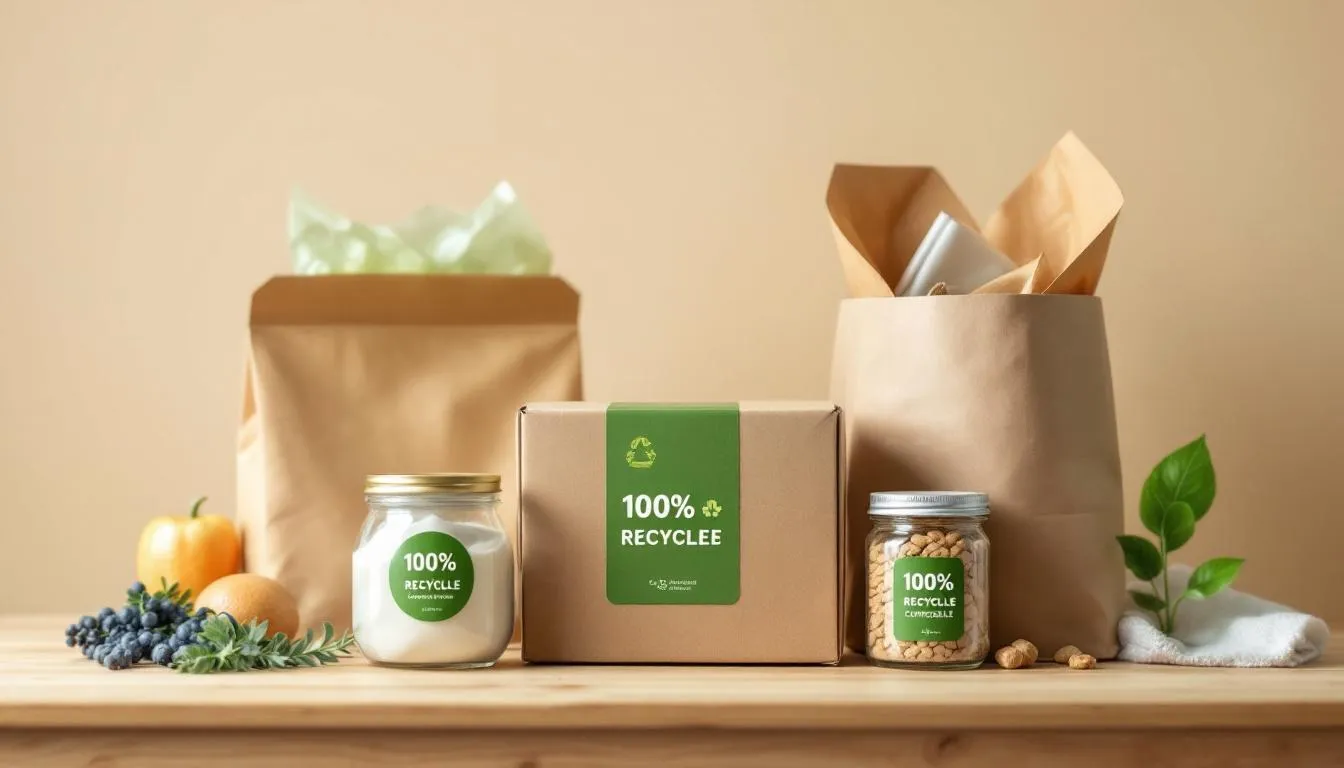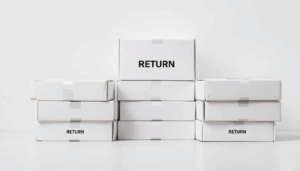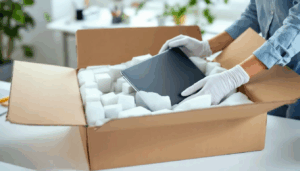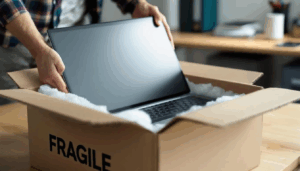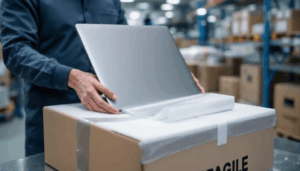In 2024, 68% of global consumers consider sustainability a crucial factor in their purchasing decisions, making eco-friendly packaging more than just an environmental initiative—it’s a business imperative. The packaging industry accounts for over 40% of total plastic demand worldwide, yet less than 10% of plastic packaging gets effectively recycled. This creates both a challenge and an opportunity for businesses ready to embrace sustainable packaging solutions.
Eco-friendly packaging represents a fundamental shift toward materials and processes that minimize environmental impact throughout their entire lifecycle. From renewable sourcing to end-of-life disposal, these packaging solutions are designed to reduce waste, lower carbon footprint, and support a circular economy while maintaining the protection and functionality your products need.
This comprehensive guide will explore everything you need to know about implementing eco-friendly packaging options for your business, from understanding different sustainable materials to calculating costs and measuring success.
Key Takeaways
- Eco-friendly packaging includes biodegradable, compostable, and recyclable materials that reduce environmental impact
- Popular sustainable options include recycled paper mailers, seaweed-based packaging, and post-consumer waste materials
- Businesses can reduce shipping costs while improving brand reputation through sustainable packaging choices
- Innovative materials like PLA bioplastics and algae-based inks are revolutionizing the packaging industry
- Custom branding options are available for eco-friendly packaging without compromising sustainability goals
What is Eco-Friendly Packaging
Eco friendly packaging refers to packaging solutions designed to minimize negative environmental impacts throughout their lifecycle. These solutions primarily use materials that are renewable, recyclable, biodegradable, or compostable, and are crafted to reduce waste, carbon emissions, and reliance on fossil fuels. By adopting these practices, eco-friendly packaging plays a crucial role in protecting the environment and supporting ecological preservation.
The fundamental attributes of sustainable packaging include reduced resource use during manufacturing, the end-of-life ability to be reused, recycled, or composted, and sourcing from sustainably managed supply chains. Well-established certifications add commercial credibility and consumer trust to these eco-friendly materials.
Key Certifications to Look For
When selecting eco-friendly packaging options, several certifications ensure authenticity and quality:
- FSC (Forest Stewardship Council): Indicates wood-based materials are sourced from responsibly managed forests
- Compostable Certifications (BPI, OK Compost): Confirm that packaging meets compostability standards in industrial or home composting environments
- Recycled Content (Post-Consumer Recycled, PCR): Shows the proportion of recycled input materials used in production
Packaging can be classified as eco-friendly if it reduces waste, conserves resources, and avoids toxicity at every stage from raw material harvesting to disposal or reuse. This comprehensive approach ensures that businesses choosing sustainable packaging solutions make a genuine environmental impact.
Types of Sustainable Packaging Materials
The wide array of eco-friendly packaging options available today spans from traditional recycled materials to cutting-edge innovations derived from seaweed and mushrooms. This variety of sustainable packaging materials and solutions allows businesses to choose options that best fit their products and environmental goals. Understanding these different categories helps businesses select the right packaging for their specific needs.
Paper-Based Solutions
Paper-based packaging remains one of the most accessible and versatile sustainable packaging options for businesses across industries.
Businesses can choose box solutions that are customizable for branded packaging, made from eco-friendly materials, and designed for practical shipping needs.
Recycled Paper and Cardboard Recycled paper pulp and cardboard, typically made from post-consumer waste, offer excellent protection for shipping boxes and padded mailers. These materials can be recycled several times before fibers degrade, and FSC certifications indicate responsible sourcing. When fibers eventually shorten beyond usability, fresh virgin pulp is introduced to maintain structural integrity.
Kraft Paper Options Kraft paper stands out among eco-friendly materials due to its production process that uses almost all parts of the tree with a closed-loop chemical system. This makes it more sustainable than regular white paper while offering durability for mailers, bags, and custom-branded packaging. Many companies offer Kraft paper solutions with full-color printing capabilities.
Molded Fiber Applications Converted into trays, cartons, and protective packaging, molded fiber is particularly favored for electronics and foodservice applications. Its protective properties, combined with full recyclability, make it an excellent choice for businesses requiring secure product packaging.
Bioplastic Alternatives
Modern bioplastics offer performance comparable to conventional plastics while supporting biodegradable packaging goals.
The market for bioplastics is rapidly emerging, driven by rising demand for biodegradable packaging solutions made from renewable resources.
PLA (Polylactic Acid) Produced from corn starch or sugarcane. PLA provides excellent clarity for food containers and wraps. While industrially compostable, it typically requires commercial composting facilities rather than home composting systems. This bioplastic has found success in food packaging applications where transparency and barrier properties are essential.
PHA (Polyhydroxyalkanoates) These biopolymers, produced by bacteria using plant oils and sugars, represent a breakthrough in marine-degradable materials. PHA offers particular promise for single-use items that might accidentally enter ocean environments, addressing a critical environmental concern.
Starch-Based Solutions Made from potato, corn, or other starches, these biodegradable materials serve as excellent alternatives to expanded polystyrene. PaperFoam and similar starch-based products provide cushioning protection while remaining completely biodegradable.
Innovative Materials
The development of truly innovative sustainable packaging materials continues to expand possibilities for eco-friendly packaging solutions.
Seaweed-based packaging Companies like Notpla and Sway are pioneering seaweed-based packaging that can replace plastic films and sachets. Sourced from fast-growing seaweed, these materials are completely biodegradable and offer unique properties for food packaging applications.
Mushroom Packaging (Mycelium) Mycelium packaging involves growing mushroom roots in molds around biomass, creating rigid, lightweight protection for fragile goods. This innovative material biodegrades fully within weeks after disposal while providing excellent protective qualities during shipping.
Algae-Based Innovations Algae ink represents another breakthrough in sustainable packaging, eliminating petroleum-based colorants and reducing eco-toxicity in printing processes. Additionally, algae-based films are being developed for various packaging applications.
Hemp, Bamboo, and Bagasse. These fast-growing, low-impact crops provide fiber for both rigid and flexible packaging solutions. From food containers to bottles, these materials support diverse applications while maintaining rapid renewability.
Biodegradable and Compostable Options
Biodegradable and compostable packaging options are at the forefront of sustainable packaging innovation, offering businesses a powerful way to reduce their environmental impact. These eco-friendly packaging solutions are designed to break down naturally, either through microbial activity in the environment or in composting systems, leaving behind no harmful residues. Compostable packaging, such as plant-based bioplastics and mushroom-derived materials, provides a sustainable alternative to conventional plastics, ensuring that packaging returns safely to the earth after use.
Biodegradable materials, including algae ink and sugarcane-based packaging, are also gaining traction for their ability to decompose efficiently and support a lower carbon footprint. By choosing compostable packaging and biodegradable materials, businesses can significantly reduce waste, support a circular economy, and demonstrate a strong commitment to sustainability. These options not only help minimize landfill contributions but also appeal to environmentally conscious customers who value brands that prioritize eco-friendly packaging solutions. Adopting these innovative materials allows companies to offer packaging that is both functional and aligned with modern sustainability goals, making a positive impact on the environment and their brand reputation.
Recycled Materials in Packaging
Incorporating recycled materials into packaging is a proven strategy for businesses aiming to reduce their environmental impact and promote sustainability. Packaging solutions made from recycled paper, cardboard, and plastics are now widely available, offering a diverse range of products such as boxes, bags, and pouches. Many companies are taking the lead by providing packaging made from 100% recycled materials, which not only conserves valuable resources but also helps to decrease landfill waste and lower greenhouse gas emissions.
By selecting packaging solutions that utilize recycled content, businesses can demonstrate a clear commitment to sustainability and responsible resource management. These materials often perform just as well as their virgin counterparts, ensuring that products remain protected while supporting environmental goals. Additionally, using recycled materials in packaging can enhance a company’s reputation among eco-conscious customers and set a positive example within their industry. As more businesses adopt recycled packaging, the collective impact on waste reduction and resource conservation continues to grow, making it an essential component of any sustainable packaging strategy.
Benefits of Eco-Friendly Packaging
Implementing sustainable packaging offers substantial environmental, economic, and reputational advantages that extend far beyond basic environmental compliance. A company can further its sustainability goals by partnering with eco-friendly packaging providers and suppliers that focus on recycled materials and waste reduction.
Environmental Impact Reduction
Eco-friendly packaging solutions significantly reduce carbon footprint, landfill waste, and ocean pollution by steering away from fossil-based, non-degradable plastics. Compostable packaging helps build healthy soils while recycled content reduces demand for virgin resources. The production processes for many sustainable materials also require less energy and water compared to traditional packaging manufacturing.
Brand Reputation and Customer Loyalty
Consumer research consistently shows that sustainability influences purchasing decisions, with environmentally conscious customers showing higher brand loyalty. Companies using eco-friendly packaging enjoy positive perception benefits that translate into increased customer retention and word-of-mouth marketing. This reputation enhancement often justifies the initial investment in sustainable packaging options.
Economic Advantages
While initial costs may be higher, lightweight and efficiently designed sustainable packaging often reduces shipping costs. Long-term savings accrue from regulatory compliance benefits and customer preference trends that offset higher up-front material costs. Many businesses find that wholesale pricing for eco-friendly packaging becomes competitive as order volumes increase.
Regulatory Compliance
Sustainable packaging helps businesses meet growing government mandates on plastics reduction and Extended Producer Responsibility (EPR) requirements. Staying ahead of regulatory changes positions companies favorably as environmental regulations continue to tighten globally.
Industry Applications and Case Studies
Real-world implementation of eco-friendly packaging solutions demonstrates the versatility and effectiveness of sustainable materials across diverse business sectors. By exploring these case studies, businesses can learn how to better understand and address their specific needs, sustainability goals, and preferences when implementing eco-friendly packaging strategies.
eCommerce Success Stories
Brands ranging from small operations processing 1,000 orders weekly to large enterprises handling 5 million+ weekly orders have successfully implemented recycled mailers and boxes. Many e-commerce businesses purchase eco-friendly boxes and mailers in packs of 100 or more for convenience and cost savings. Allbirds and Patagonia exemplify this trend, using 100% recycled cardboard mailers to reinforce their sustainability messaging while maintaining product protection and custom branding capabilities.
Food and Beverage Applications
The food industry has embraced compostable pouches with high-barrier coatings for products ranging from snacks to coffee. Organic produce sellers at farmers’ markets frequently choose cellulose wraps, while larger food companies are adopting certified compostable packaging that meets both food safety and environmental requirements.
Cannabis Industry Innovation
Stringent packaging regulations in the cannabis industry have encouraged companies to adopt compostable, child-resistant packaging solutions. This alignment of legal compliance with environmental responsibility demonstrates how regulatory requirements can drive sustainable innovation.
Apparel and Fashion
Clothing brands increasingly utilize poly-bags made from PLA or recycled PCR plastic, significantly reducing single-use plastic waste in shipping. Custom-branded options allow fashion companies to maintain their aesthetic while supporting sustainability goals.
Shipping and Mailer Solutions
Shipping and mailer solutions are essential components of the packaging process, and there is a growing selection of eco-friendly options designed to minimize environmental impact. Recyclable padded mailers, for instance, provide a sustainable alternative to traditional plastic-based mailers. Made from recycled paper and designed for reuse or recycling, these mailers help businesses reduce waste and support a circular economy.
In addition to recyclable options, many companies now offer biodegradable and compostable shipping solutions, such as mushroom-based packaging and plant-based bioplastics. These materials break down naturally, further reducing the carbon footprint associated with shipping and delivery. By integrating eco-friendly shipping and mailer solutions into their operations, businesses can not only lower their environmental impact but also appeal to customers who prioritize sustainability. These solutions offer reliable protection for products during transit while reinforcing a company’s commitment to responsible packaging practices. As the demand for sustainable shipping grows, businesses that adopt these innovative mailers and packaging materials position themselves as leaders in environmental stewardship.
Choosing the Right Eco-Friendly Packaging
Selecting appropriate sustainable packaging requires balancing product protection, customer experience, branding needs, end-of-life pathways, and cost constraints. When choosing eco-friendly packaging, it is also important to select sustainable labels, such as compostable or recyclable options, to ensure the entire packaging solution is environmentally responsible. This decision-making process involves several key considerations that ensure both environmental and business objectives are met.
Product Protection Requirements
The right packaging must first and foremost protect your products during shipping and storage. Evaluate whether your items require moisture barriers, cushioning protection, or temperature resistance. Many eco-friendly materials now offer performance characteristics comparable to traditional packaging, but matching specific protection needs remains crucial.
End-of-Life Considerations
Consider the disposal infrastructure available in your target markets. Will customers have access to industrial composting facilities for compostable packaging, or should you focus on recyclable options that work with existing municipal recycling programs? Home compostable materials offer the most convenience for consumers but may have performance limitations.
Branding and Customization Needs
Custom branding does not preclude sustainability goals. Many suppliers offer eco-certifications alongside full-color printing and custom designs. Evaluate how your packaging communicates your brand values while supporting your environmental commitments.
Volume and Cost Analysis
Sample testing and pilot programs help determine the best sustainable packaging options before full-scale implementation. Consider how your order volumes affect pricing, as wholesale rates often make eco friendly packaging more cost-competitive.
Cost Considerations and Implementation
Understanding the financial aspects of transitioning to sustainable packaging helps businesses make informed decisions and plan successful implementations. Choosing reusable packaging options can provide long-term cost savings and environmental benefits, making them a smart investment for businesses seeking both sustainability and reduced expenses.
Initial Investment vs. Long-Term Value
While eco-friendly packaging materials often cost 10-20% more initially, this premium is frequently offset by efficiency gains, customer loyalty benefits, and regulatory compliance advantages. Government incentives and tax benefits for sustainable practices are increasingly available to help offset transition costs.
Supplier Partnerships
Working with specialized suppliers like EcoEnclose, Elevate Packaging, ClearBags, or noissue can significantly reduce per-unit costs through wholesale pricing and expert guidance. These partnerships often provide access to custom branding options without compromising sustainability credentials.
Implementation Strategy
Successful transitions typically involve:
- Starting with pilot programs to test customer acceptance
- Gradually expanding sustainable packaging across product lines
- Training staff on proper handling and storage of new materials
- Communicating changes to customers to reinforce brand values
- Monitoring performance metrics to ensure protection standards are maintained
ROI Measurement
Track metrics including customer satisfaction, shipping damage rates, brand perception surveys, and cost per shipment to measure the success of your sustainable packaging implementation. Many companies find that initial investments pay for themselves within 12-18 months through improved efficiency and customer loyalty.
Common Challenges and Solutions
While the benefits of sustainable packaging are clear, businesses often encounter challenges when transitioning to eco-friendly packaging solutions. One common hurdle is finding materials that balance sustainability with the necessary functionality, such as durability, barrier protection, and product safety. Additionally, the higher upfront cost of some eco-friendly packaging options can be a concern, especially for small and medium-sized businesses.
To overcome these challenges, companies can collaborate with packaging suppliers to develop custom solutions tailored to their specific needs. Many suppliers now offer a wide range of sustainable packaging options, including recyclable and biodegradable materials, at competitive prices. By exploring these offerings and leveraging supplier expertise, businesses can identify packaging solutions that meet both their budget and performance requirements. Additionally, piloting new materials and gradually scaling up can help manage costs and ensure a smooth transition. With the growing availability of innovative and affordable eco-friendly packaging solutions, businesses can confidently make the switch to sustainable packaging while maintaining product quality and customer satisfaction.
Best Practices for Sustainable Packaging
Adopting sustainable packaging solutions requires a strategic approach to maximize both environmental and business benefits. One of the most effective best practices is to select packaging materials that are recyclable, compostable, or biodegradable, ensuring that packaging can be responsibly disposed of at the end of its life. Businesses should also consider the carbon footprint of their packaging choices, opting for materials and production processes that minimize environmental impact.
Optimizing packaging design is another key practice—using the right packaging size and reducing excess material helps cut down on waste and shipping costs. Providing clear information to customers about how to recycle or compost packaging materials further promotes sustainability and encourages responsible disposal. Additionally, businesses can explore a wide array of eco-friendly packaging options, such as bags, boxes, and pouches, to find the best fit for their products and brand identity.
By selecting the right packaging and educating customers, businesses can ensure their products are protected while actively promoting sustainability. These best practices not only reduce environmental impact but also enhance brand reputation and customer loyalty, positioning companies as leaders in the movement toward a more sustainable future.
Future Trends in Sustainable Packaging
The evolution of eco-friendly packaging continues to accelerate, driven by technological innovation, regulatory pressure, and consumer demand for more sustainable business practices.
Circular Packaging Systems
The industry is shifting toward packaging designed for multiple reuse cycles, full recyclability, or complete compostability with zero waste targets. These circular systems require collaboration between manufacturers, retailers, and consumers to create closed-loop material flows.
Smart Packaging Integration
Embedded QR codes and RFID tags on sustainable materials provide transparency about sourcing, recycling instructions, and disposal methods. This technology helps consumers make informed decisions while supporting proper end-of-life handling.
Infrastructure Development
Investment in home composting networks and improved recycling facilities is expanding the viability of various eco-friendly packaging options. This infrastructure development makes previously impractical sustainable materials more accessible to businesses and consumers.
Regulatory Evolution
Governments worldwide are implementing stricter bans and taxes on single-use plastics while mandating minimum recycled content requirements. These regulatory changes are accelerating the adoption of sustainable packaging solutions across all industries.
Material Science Advances
Ongoing research and development are producing new materials like edible films and enzyme-accelerated biodegradable plastics. Improved barrier properties for moisture and oxygen are expanding the applications where eco-friendly materials can effectively replace conventional packaging.
FAQ
What makes packaging truly eco-friendly? Eco-friendly packaging uses renewable materials, reduces waste throughout its lifecycle, and can be recycled, composted, or biodegraded safely. Look for certifications like FSC, BPI compostable, or high post-consumer recycled content to verify sustainability claims.
Is eco-friendly packaging more expensive? Initial costs may be 10-20% higher than conventional packaging, but savings often result from shipping efficiency, customer loyalty, and regulatory compliance benefits. Wholesale pricing and government incentives help offset the premium.
How do I know if packaging is genuinely sustainable? Check for third-party certifications such as FSC for paper products, BPI for compostable materials, or recycled content standards. Avoid vague terms like “eco-friendly” without specific certifications backing the claims.
Can eco-friendly packaging protect products effectively? Yes, modern sustainable materials offer excellent protection while maintaining environmental benefits. Materials like molded fiber, kraft paper, and advanced bioplastics provide barrier properties and mechanical protection comparable to conventional options.
Where can I source eco-friendly packaging? Specialized suppliers like EcoEnclose, Paper Mart, Elevate Packaging, and noissue offer comprehensive sustainable packaging solutions with custom branding options. Many provide wholesale pricing for businesses ordering in volume.
What disposal options work best for customers? Consider your customers’ access to disposal infrastructure. Recyclable materials work with existing municipal programs, while compostable options require either home composting capability or access to commercial composting facilities.
How should I communicate packaging changes to customers? Highlight the environmental benefits and proper disposal instructions clearly on packaging and marketing materials. Many customers appreciate transparency about sustainability efforts and disposal guidance.
Are there eco-friendly envelopes available for shipping? Yes, there are eco-friendly envelopes designed for shipping, including recyclable padded envelopes and mailers. These options are made from sustainable materials, offer durability and lightweight protection for products, and are suitable for businesses seeking environmentally responsible packaging solutions.
The transition to eco-friendly packaging represents both an environmental imperative and a business opportunity. By understanding the available materials, benefits, and implementation strategies, businesses can make informed decisions that support both their sustainability goals and operational needs. Whether you’re exploring recycled paper solutions, innovative bioplastics, or cutting-edge materials like seaweed packaging, the key is selecting options that align with your product requirements, customer values, and disposal infrastructure.
As consumer demand for sustainable business practices continues to grow and regulations become more stringent, eco-friendly packaging will become not just a competitive advantage but a necessity. Companies that invest in sustainable packaging solutions today position themselves for long-term success while contributing to a more sustainable future.
Ready to explore sustainable packaging options for your business? Start by evaluating your current packaging needs, researching certified suppliers, and testing sample materials to find the perfect eco-friendly packaging solutions for your products.

